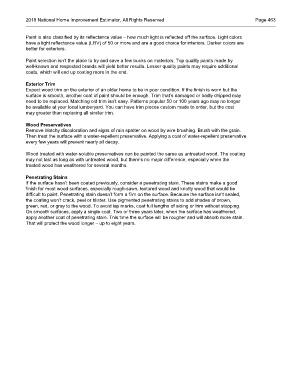Page 584 - 2018 National Home Improvement
P. 584
2018 National Home Improvement Estimator, All Rights Reserved Page 463
Paint is also classified by its reflectance value – how much light is reflected off the surface. Light colors
have a light reflectance value (LRV) of 50 or more and are a good choice for interiors. Darker colors are
better for exteriors.
Paint selection isn’t the place to try and save a few bucks on materials. Top quality paints made by
well-known and respected brands will yield better results. Lesser quality paints may require additional
coats, which will end up costing more in the end.
Exterior Trim
Expect wood trim on the exterior of an older home to be in poor condition. If the finish is worn but the
surface is smooth, another coat of paint should be enough. Trim that’s damaged or badly chipped may
need to be replaced. Matching old trim isn’t easy. Patterns popular 50 or 100 years ago may no longer
be available at your local lumberyard. You can have trim pieces custom made to order, but the cost
may greater than replacing all similar trim.
Wood Preservatives
Remove blotchy discoloration and signs of rain spatter on wood by wire brushing. Brush with the grain.
Then treat the surface with a water-repellent preservative. Applying a coat of water-repellent preservative
every few years will prevent nearly all decay.
Wood treated with water-soluble preservatives can be painted the same as untreated wood. The coating
may not last as long as with untreated wood, but there’s no major difference, especially when the
treated wood has weathered for several months.
Penetrating Stains
If the surface hasn’t been coated previously, consider a penetrating stain. These stains make a good
finish for most wood surfaces, especially rough-sawn, textured wood and knotty wood that would be
difficult to paint. Penetrating stain doesn’t form a film on the surface. Because the surface isn’t sealed,
the coating won’t crack, peel or blister. Use pigmented penetrating stains to add shades of brown,
green, red, or gray to the wood. To avoid lap marks, coat full lengths of siding or trim without stopping.
On smooth surfaces, apply a single coat. Two or three years later, when the surface has weathered,
apply another coat of penetrating stain. This time the surface will be rougher and will absorb more stain.
That will protect the wood longer – up to eight years.

